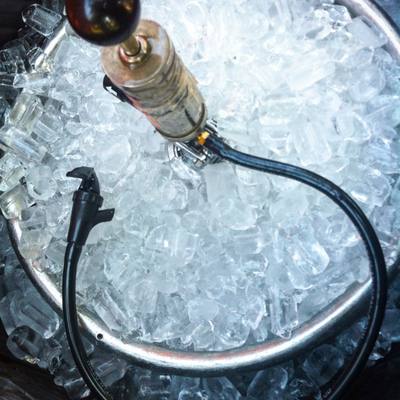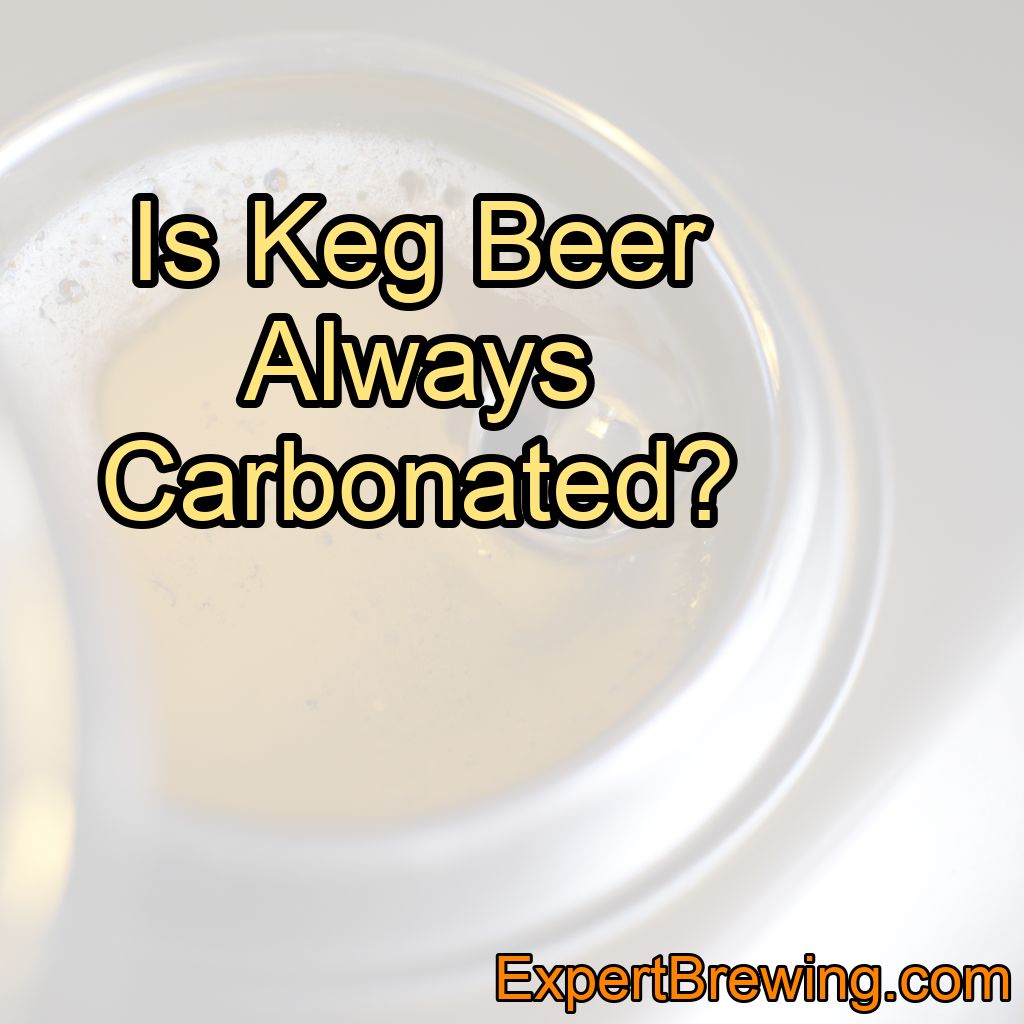Is keg beer always carbonated? The short answer is no. Keg beer comes in a variety of styles and carbonation levels, depending on the brewer’s intentions and the specific recipe used.
As an experienced brewer, I’ve had the opportunity to try countless keg beers, and I can assure you that not all keg beers are carbonated.
In this blog post, we’ll explore the world of keg beer and dive into the various factors that influence its carbonation.
We’ll discuss the different types of keg beer, the science behind carbonation, and the role that carbonation plays in flavor and mouthfeel. We’ll also touch on some tips for serving and storing keg beer to ensure optimal carbonation. So, let’s get started!
Types of Keg Beer
Ales
Ales are one of the oldest types of keg beer and are typically fermented at warmer temperatures. This results in a more complex flavor profile, often with fruity or spicy notes. Ales can range in carbonation, from lightly carbonated to highly effervescent.
Lagers
Lagers are fermented at cooler temperatures and are known for their crisp, clean flavors. They are typically more carbonated than ales, with a fine, persistent bubble structure.
Stouts and Porters
These darker, maltier beers are often less carbonated than their lighter counterparts. The lower carbonation levels help to accentuate the rich, roasted flavors and creamy mouthfeel.
Cask-Conditioned Ales
Cask-conditioned ales are a unique category of keg beer, as they continue to ferment and develop carbonation naturally in the keg. These beers are often served with less carbonation than other keg beers, resulting in a smoother, less fizzy drinking experience.
The Science Behind Carbonation
Carbonation in beer is created by the dissolution of carbon dioxide (CO2) in the liquid. During fermentation, yeast consumes sugar and produces alcohol and CO2 as byproducts. The CO2 that is produced can either be allowed to escape or be captured and forced back into the beer, resulting in carbonation.

In kegged beer, carbonation is typically achieved through forced carbonation. This involves chilling the beer and applying CO2 pressure to dissolve the gas into the liquid. The level of carbonation can be adjusted by altering the temperature and pressure, allowing for a wide range of carbonation levels in keg beer.
Carbonation’s Role in Flavor and Mouthfeel
Carbonation plays a crucial role in the overall sensory experience of drinking beer. The release of CO2 as bubbles enhances the aroma of the beer, as the gas carries volatile compounds to the surface, where they can be detected by our noses.
In terms of mouthfeel, carbonation can provide a refreshing, crisp sensation, or contribute to a creamy, smooth texture, depending on the level of carbonation and the style of beer. Highly carbonated beers can also help to cleanse the palate between bites of food, making them ideal accompaniments to a meal.
Serving and Storing Keg Beer
Serving Temperature
Serving temperature is an essential factor in ensuring optimal carbonation levels in keg beer. Colder temperatures allow for higher levels of dissolved CO2, while warmer temperatures cause CO2 to be released more quickly.

This means that serving a keg beer too warm can result in a flat, lifeless beer, while serving it too cold can make it excessively carbonated and difficult to pour.
CO2 Pressure
When serving keg beer, it’s important to use the correct CO2 pressure to maintain the desired level of carbonation. Too much pressure can over-carbonate the beer, leading to excessive foam and a sharp, harsh mouthfeel. Conversely, too little pressure can cause the beer to lose carbonation and become flat.
Keg Storage
To maintain optimal carbonation levels, kegs should be stored in a cool, dark place, away from heat and direct sunlight. This helps to minimize fluctuations in temperature that can affect carbonation levels.
Conclusion
In conclusion, keg beer is not always carbonated, and the level of carbonation can vary widely depending on the style of beer and the brewer’s intentions. Carbonation plays a significant role in the flavor and mouthfeel of beer and is influenced by factors such as serving temperature and CO2 pressure. By understanding the science behind carbonation and following best practices for serving and storing keg beer, you can ensure that your beer is enjoyed at the optimal level of carbonation.
10 Facts About Keg Beer Carbonation
1. Keg beer is not always carbonated – carbonation levels can vary depending on the style of beer and the brewer’s intentions.
2. Ales, lagers, stouts, and porters can all have varying levels of carbonation.
3. Cask-conditioned ales are typically less carbonated than other keg beers.
4. Carbonation is created by the dissolution of carbon dioxide (CO2) in beer.
5. Kegged beer is often carbonated through a process called forced carbonation.
6. Carbonation enhances the aroma of beer and plays a role in mouthfeel.
7. Serving temperature affects the carbonation level of keg beer.
8. Using the correct CO2 pressure is crucial for maintaining optimal carbonation levels.
9. Kegs should be stored in a cool, dark place to maintain carbonation.
10. Understanding the science behind carbonation and following best practices for serving and storing keg beer can help ensure a great drinking experience.
FAQs
Why is there no carbonation in my keg?
There could be several reasons why there is no carbonation in your keg. One possibility is that the CO2 pressure in the keg is too low. Check if the CO2 tank is properly connected and the pressure is set to the appropriate level. Another reason could be a leak in the system, causing the CO2 to escape. Inspect all the connections and fittings for any signs of leaks. Additionally, ensure that the keg is properly sealed, as a faulty seal can result in lost carbonation. Finally, make sure that the keg has been given enough time for carbonation to occur. Carbonation typically takes a few days to fully develop, so be patient and allow sufficient time for the process.
How long does beer stay carbonated in a keg?
The carbonation in a keg of beer can typically last for several weeks to a few months, depending on various factors such as the type of beer, temperature, and the quality of the keg’s seal.
How do you force carbonate a keg at 30 psi?
To force carbonate a keg at 30 psi, you will need to follow these steps:
1. Ensure that your keg is properly sanitized and sealed.
2. Connect the gas line from your CO2 tank to the gas-in post on the keg.
3. Set your CO2 regulator to a pressure of 30 psi.
4. Shake or roll the keg gently for a few minutes to increase the surface area contact between the beer and CO2.
5. Allow the keg to sit for a period of time, typically 24 to 48 hours, at the desired pressure and temperature (around 38°F or 3°C) for optimal carbonation.
6. After carbonation, reduce the pressure to your desired serving pressure (typically around 10-12 psi) to dispense the beer.
Remember to monitor the carbonation process and adjust the pressure and time as needed to achieve the desired level of carbonation.
How do you know if your keg is over carbonated?
One way to determine if your keg is over carbonated is by observing excessive foaming when pouring. If the beer comes out with a lot of foam, even with a gentle pour, it could indicate over carbonation. Additionally, if the beer tastes excessively fizzy or has a sharp, prickly carbonation sensation on the palate, it may be a sign of over carbonation.
How do you force carbonate a keg?
To force carbonate a keg, you will need a CO2 tank, a regulator, and a carbonation stone. First, ensure that your keg is properly cleaned and sanitized. Then, connect the CO2 tank to the regulator and set the desired pressure. Attach the carbonation stone to the gas line and place it at the bottom of the keg. Slowly introduce CO2 into the keg, allowing it to bubble through the liquid. This process helps dissolve CO2 into the beer, carbonating it. Leave the keg under pressure for a specific duration, typically a few days, to achieve the desired carbonation level. Remember to periodically check the carbonation and adjust the pressure if needed.
Is there a beer without carbonation?
Yes, there are beer styles that have lower levels of carbonation or are naturally less carbonated. Examples include cask-conditioned ales, some traditional Belgian lambics, and certain sour beers. These styles often have a softer and more subtle carbonation compared to highly carbonated beers like lagers or pale ales.




